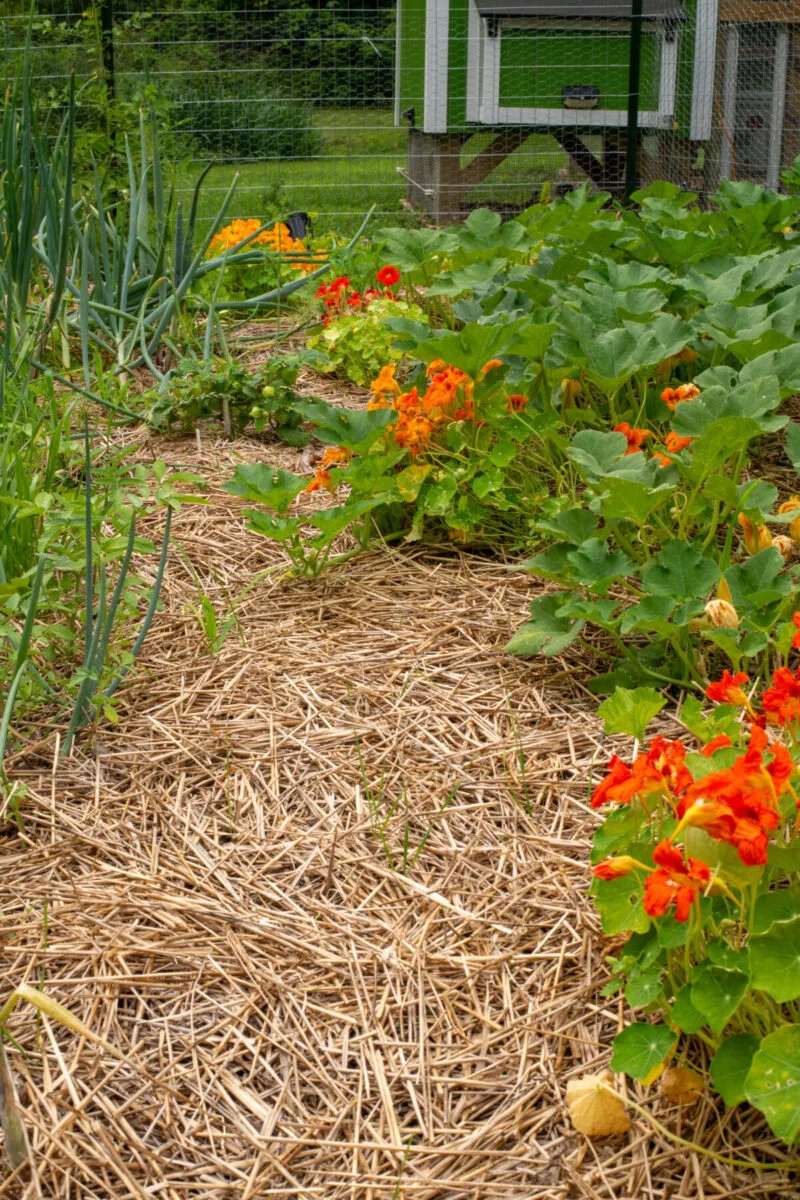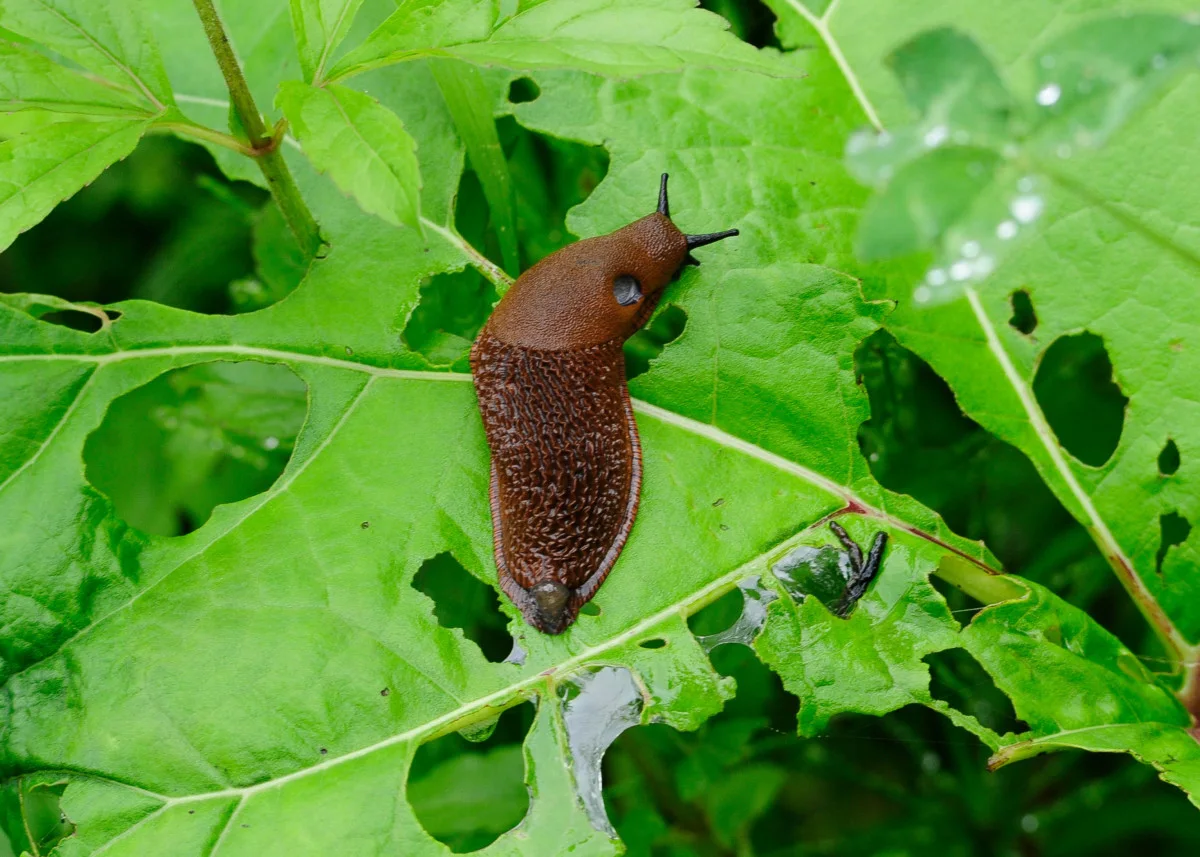
I don’t grow a garden without mulch. Period. Putting down a protective layer over the bare soil in my garden provides a multitude of benefits. Unfortunately, after three successive seasons of mulching with straw, I think it’s time I break up with this go-to mulching material. It’s been nothing but trouble.
Mulching your garden is important for numerous reasons. What are they, you ask?

Mulching your garden:
- prevents water from evaporating.
- suppresses weed growth.
- provides shade and helps to keep soil cool during times of intense heat.
- breaks down over time, adding nutrients and organic matter to the soil.
But the most important reason why I mulch my garden every year is I’m lazy, and I don’t want to spend 30 hours a week in my garden. I want to set my garden up so it’s on autopilot (as much as it can be), and all I need to do is pick veggies and fertilize once in a while.
The less I have to fuss over it, the better.
My decision to use straw mulch for the past three years has ended up making more work for me rather than less. This season was the final…straw. (Ha, I walked right into that one.) I won’t be using it in my garden going forward.
Why is Straw so Popular?

With so many materials that can be used as mulch, straw remains one of the most popular mulchess mainly because it’s inexpensive and easy to source. A bale of straw in my neck of the woods will set you back about $8. I can mulch my entire garden with two bales. That’s not bad.
For many folks, it’s one of the only mulching materials that’s available to them in the quantities they need to cover their entire garden. I would love to mulch our garden with the leaves from our oak tree each year. There just aren’t enough of them to do the entire garden.
Finally, it’s a good mulch and works well for lots of gardeners (just not this one).
The Difference Between Hay & Straw
I figure this is an important distinction to make for the uninitiated. Hay and straw are not the same. Straw is the leftover stems of commercially harvested grains—things like oats, barley and wheat. The seed heads are cut and removed to be sold to granaries. This leaves tons of the long stems – straw.
Rather than wasting them, they’re bailed and sold. Straw, in theory, shouldn’t contain the seeds of whatever plant it came from.
Hay, on the other hand, is fodder for animals. It does contain the seeds of whatever was growing in that particular field: timothy, clover, alfalfa, etc. You don’t want to sprinkle this all over your garden.
Now, on to my gripes with straw.
I’ve consistently run into three of the biggest complaints gardeners have about straw mulch. These issues have become so persistent that I’ve decided I don’t want it in my garden anymore.
The Weeds

Look, the main reason I mulch is because I want to weed less, not more.
In theory, straw should be nothing but the leftover stems of grains. That being said, I always find that the bales of straw I’ve purchased are loaded with seed heads. This would be fine if I found them before I put the straw in the garden.

It never plays out that way.
After those first few spring rains, my straw mulch that is supposed to suppress weeds is nothing but weeds. I spend several weeks yanking up freshly sprouted cereal grains from my garden.
These weeds usually have a large root system that spreads fast, so when I pull them up, they end up taking a lot more soil with them than other weeds in my garden. I’m left with large divots in the garden.

So much for mulch leaving me with less weeding to do.
Slugs, Slugs, and More Slugs
I have used straw as mulch for the past three years. In those three years, I have had more slugs in my garden than I have in my entire time gardening (at least three decades).

We’re not talking about the cute little guys that look like they belong in a Beatrix Potter illustration. We’re talking about the huge ones that can take out an entire head of lettuce in an afternoon. It’s to the point where I’ve just accepted the fact that most of my produce will have slug damage. Yum.
And they are everywhere.
I can lift the mat of straw anywhere in the garden and find several slugs hiding beneath it. My straw mulch is a slug hotel, and it is full to capacity. It’s probably overbooked. Someone call the fire marshal.
Now, to be fair, I do live in an area of the country where we receive rain frequently enough that I rarely need to water my garden. Using mulch means my soil stays moist on its own, leading to the perfect habitat for slugs to hang out.
In this case, I don’t know if a different type of mulch would work better or not. What I do know is that the slugs seem to prefer straw, and it doesn’t break down quickly, so they stay protected beneath it for the whole season, if not longer.
Chemicals on Straw
This last one took me by surprise, and I’m a little disappointed in myself that I didn’t make the connection sooner. Nearly all straw available for purchase has been treated with an herbicide or a pesticide, sometimes both.
Some of these chemicals degrade pretty quickly in the sun or air, meaning by the time the straw reaches you, there will be little or no chemicals left on it. That’s good!
One of the most widely used herbicides out there is glyphosate, which breaks down quickly in the sun. However, we’re now finding that it can stay in the soil, causing nutrient uptake issues in plants grown in that soil. This may or may not be an issue we need to consider. You don’t want to introduce this stuff into your garden soil.
Some of these chemicals don’t degrade quickly and stick around, meaning you’re covering your garden in straw treated with chemicals meant to suppress plant growth or certain types of insects. It’s not an ideal scenario if you’re an organic gardener or looking to improve your soil.
Sourcing Safe Straw

There are two ways to get around this issue. One is to buy organic straw, and the other is to test your straw before you put it in your garden. This sounds easy enough, and these workarounds might be fine for other gardeners but not for me.
First, organic straw is nearly impossible to find.
I called around to Tractor Supply, Rural King and the local landscaping centers that sell straw bales. Not only did none of them have certified organic straw, but they all sounded as though I was asking if they had gold-plated straw. Clearly, this is not something that is requested often.
I searched the almighty Amazon, and while I did find plenty of “organic mulches,” in this case, they meant organic matter rather than organically grown.
I finally found certified organically grown straw. It was $50 a pop and covered 75 square feet. That means if I want straw that I know is chemical-free, I would have to spend $150 every year on straw mulch. That’s quite a jump from the normal $16 for two bales. Not to mention, for those that care about these things, the two bales I buy locally were grown locally, whereas if I wanted the organic mulch from Amazon, that’s a much bigger carbon footprint.
Second is testing your straw.

The idea is simple. Take a quart mason jar and cram it full of the straw you intend to use, then fill it with water to the brim. Let it soak for a day, and then use that water to water a test plant. Beans are excellent test plants because they grow quickly and are quite sensitive to what’s going on in the soil.
You’re then going to monitor the new growth. You want to look for misshapen or discolored leaves or no new growth at all. These are indicators that you’ve got more than straw in that water. However, if your test bean continues to grow into a healthy bean plant, you’re good to go.
But this doesn’t really work for me.
It means that every time I buy straw, I have to grow a bean plant to test it on, and I need to wait a week or two while I observe the test. In the meantime, I’ve got a garden that needs to be mulched.
If, in the end, it turns out I have a bale of straw and a dead or disfigured bean plant, then what? I now have a big old bale of straw that I can’t use in my garden, and I’m certainly not going to use it for my chickens. What do I do with it?
I’m Out of Luck
At the end of the day, straw isn’t a good fit for our garden, which leaves me looking for a better alternative. (Dear Oak Tree, please put out more leaves. Thank you.) What is a good mulch instead of straw? Right now, I don’t have an answer, but rest assured, when I find one, I will come back to this post and let you know what it is.
I’m considering using a living mulch as it solves other problems we have in our garden as well.
With all that being said, straw is still a good mulch option for many gardeners. Just because it doesn’t work for me doesn’t mean it won’t work for you.
Good Reasons to Use Straw

Again, let me reiterate that straw is inexpensive and easy to find. If it’s the only mulch available to you, go ahead and use it.
Straw is especially effective in areas where drought is common, and you need to shade the soil. I’m looking at you, West Coast gardeners. Slugs are less likely to be an issue in these types of growing scenarios. (Or at least not on the same level as my Hilton for Slugs.)
Yes, testing is a pain in the butt; however, if you find a reliable local source that gets their straw from the same place each year, you may be able to find out exactly what chemicals are being used on it. You may only need to test your straw once if you have a reputable source.
In the end, straw does a good job of doing what mulch is supposed to accomplish. If you’ve been using straw mulch with no issues, then ignore this and keep using it. If you find you’re in the same boat as me, my friend, well, it might be time to look for another mulch material. If you find a good one, let me know.

Get the famous Rural Sprout newsletter delivered to your inbox.
Including Sunday musings from our editor, Tracey, as well as “What’s Up Wednesday” our roundup of what’s in season and new article updates and alerts.

